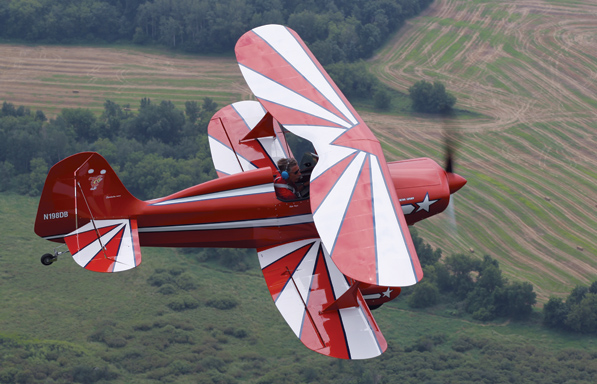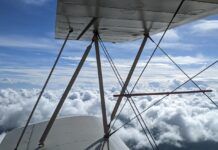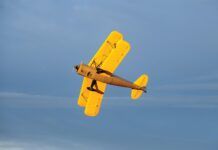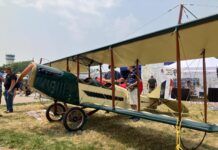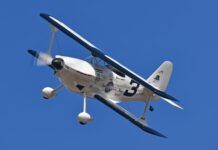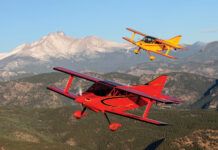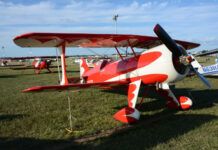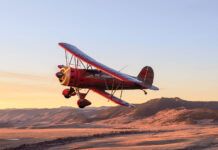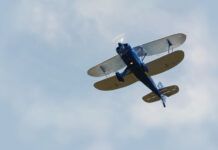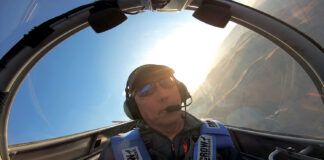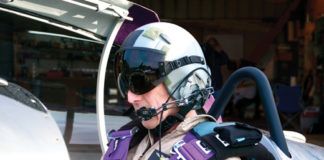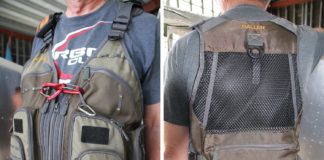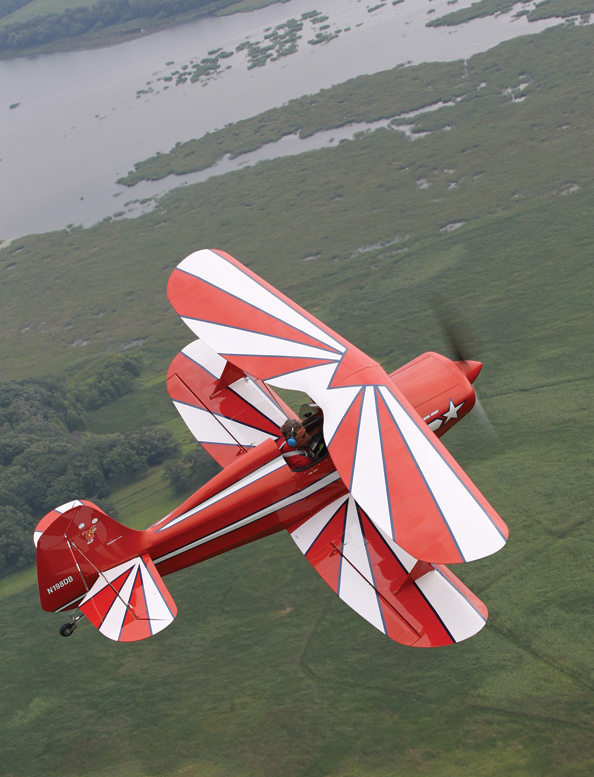
In quiet, measured words, Alan Arps reveals his subtle passion for family, friends and the romance of flight. In the 1960s, his father, Vernon, built a grass strip and hangar next to his boyhood home in Abie, 12 miles south and east of Columbus, Nebraska. Alan followed him skyward in 2002. Shortly after earning his private ticket, Alan bought a Cessna 150L. “It’s got some history with me,” he said. The Cessna that had taught him to fly, from solo to checkride, once belonged to his father, now gone 15 years. To bring it home, Alan brought the 120×2200-foot grass strip and hangar back to life. Since 2007, the Cessna has shared the hangar with a now-revitalized 1968 Stolp Starduster SA-100, a classic single-seat biplane that garnered the Paul Poberezny Founders Award for Best Classic Homebuilt at EAA AirVenture 2010.
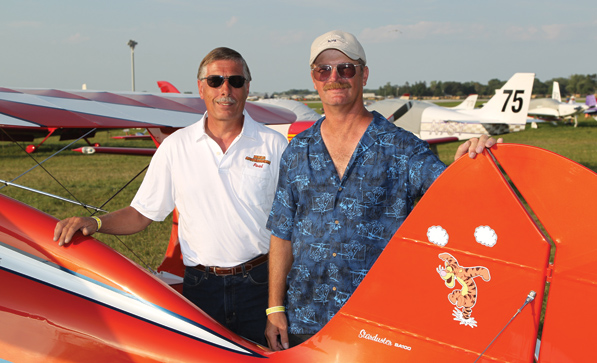
Paul Muhle (left) and Alan Arps at EAA AirVenture 2010.
Unlike his airport effort, Arps, now 55, knew he didn’t have the skills to tackle the Starduster project solo. Describing himself as “very mechanical,” Arps maintains the equipment, from backhoe and track loader to skid loader and dump truck, that serve Gopher Express, the excavating company he started in the 1990s. Having never before worked on airplanes, he says, “some things are best left to a professional.” That professional was Paul Muhle, Columbus Airport friend and proprietor of Muhle Aviation Works LLC. That seems right because Muhle, with a flight in his Grand Champion Acro Sport II, inspired Arps’ biplane passion, a love at first flight that has lasted.
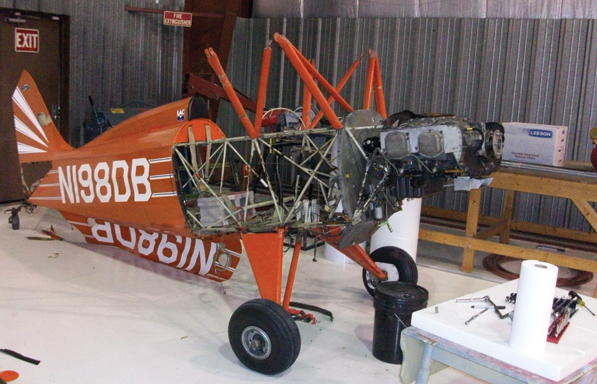
Arps stripped his Starduster of its doped 41-year-old Grade A cotton covering and sent the N-number to the airplane’s builder, Dan Bookwalter.
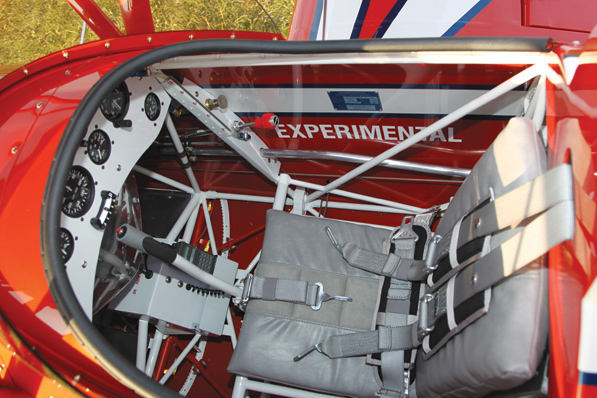
The Starduster’s revamped cockpit sports new instruments along with a lowered and more reclined seat.
Arps started looking for his own biwinger. The Pitts was not a contender. The ability to loop and roll occasionally was important, but he “wanted something that would take off and land like a Cub.” Researching his options, Arps discovered the Stolp Starduster SA-100. Lou Stolp and George Adams flew the prototype in 1957, when today’s Experimental/Amateur-Built reg was just four years old. A liberal dusting of small, white five-pointed stars on the blue biplane’s vertical tail inspired its name. With no preconceived notions, Stolp drew a plane he’d like to own, reports Budd Davisson in a sidebar to a 1995 Sport Aviation article on the two-seat Starduster Too. “I started with a place to sit,” Stolp said. Despite the Starduster’s sinuous lines, it was not a difficult build, Davisson writes, because “Stolp’s philosophy was if it could not be done in a builder’s backyard, he wouldn’t put it in the plane.”
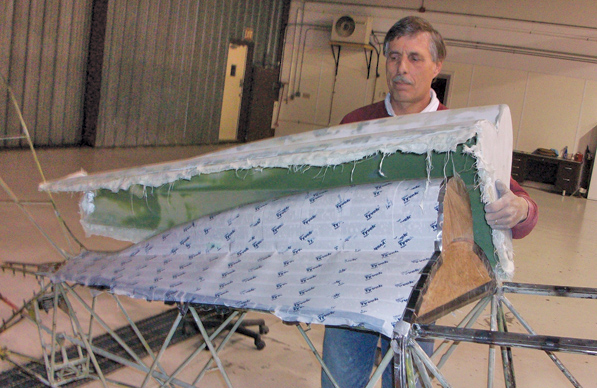
Muhle removes the new fiberglass turtledeck from the mold.
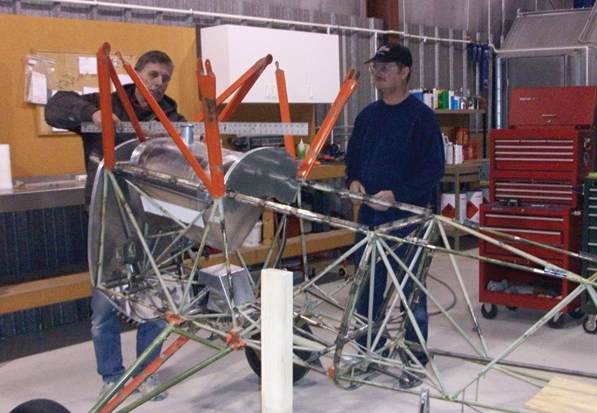
Muhle and Arps mount the new 17.3-gallon fuselage tank.
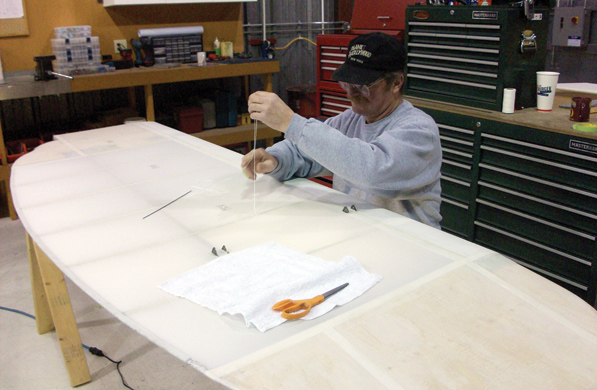
Arps learned rib-stitching, and he got plenty of practice.
Today there are fewer than 100 SA-100s in the FAA registry (Aircraft Spruce sells plans for $115). Arps found his on the Internet. Located in Chandler, Indiana, it had logged 1100 hours, with 500 on new jugs and pistons. He shot the owner a price, and the young man asked, “How about this weekend?” After lunch in Columbus, Arps became the Starduster’s fourth owner. Muhle inspected and flew the airplane, and judged it well-built, Arps said. “I bought the airplane knowing that Paul was going to redo it [even though] Paul didn’t know it” at the time.
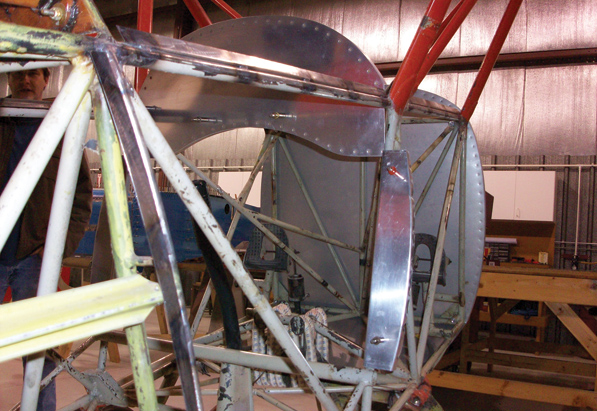
To hold the metal skins in place, Muhle replaced sheet-metal screws and fuselage-mounted taps with metal formers and nut plates.
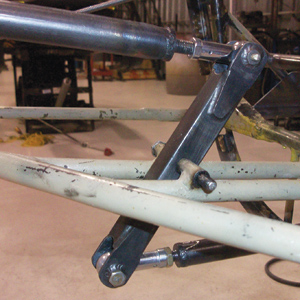
A new control idler replaced the original unit that combined riveted and bolted parts.
Arps put about 15 hours on the biplane before it moved into Muhle’s shop in late October 2009. During that time, Arps connected with the biplane’s creator, Dan Bookwalter. Now retired, Bookwalter visited Arps during a long road trip. The Starduster, Arps learned, won the 1968 consolation race for sport biplanes at Cleveland’s Lakefront Airport, competed in International Aerobatic Club competitions for five years, and from its Ohio home flew to the last two EAA fly-ins at Rockford and the first two at Oshkosh. It was then that Arps decided that the airplane would, with all work complete, return to Wisconsin.
Amending the Starduster
The difference between restore and amend is significant: restoration is repairing or rebuilding something to a former or normal condition; amendment is making an original better through improvements. From his first inspection, Muhle knew the Starduster had been cared for, but it was still 40 years old. Over a month of discussions, Muhle and Arps devised the amendment plan. With few words they agreed that the original dope-covered Grade A cotton needed replacement. Arps wanted fresh stainless steel in place of the cracked galvanized firewall dotted with unneeded holes. Muhle explained that they really wouldn’t know what else was needed until they stripped the airplane and inspected it, so the plan was to address each challenge individually, amending or restoring it to achieve the ultimate goals of improved safety, reliability, ease of inspection and maintenance, and aesthetics.
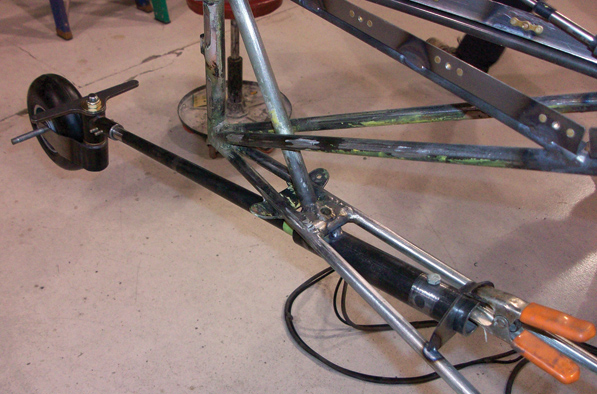
The tailwheel and spring from Muhle’s RV-7 takes its place on the Starduster.
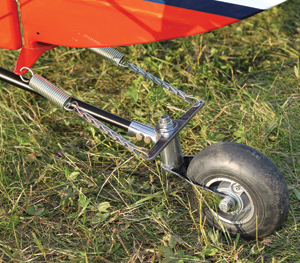
The RV-7 tailwheel on the finished airplane.
Thanks to the seasonal nature of Arps’ business, the two were able to work together uninterrupted. “We worked together, day after day, for eight months,” Arps said. He had two motives: to learn from a master craftsman and to help hold down costs. Working on the airplane was a revelation, he says, and more meticulous than he imagined. But that is the Muhle method, which earned him three Grand Champion awards and the experience needed for his A&P. “It takes less time to achieve show quality work than it does airworthy work in two or three tries because you’re in a hurry,” Muhle says without apology.
Arps did the grunt work. He stripped the fabric (and sent a piece with the N-number to Bookwalter), bead-blasted the 4130 steel-tube skeleton, and sanded and varnished the wings. He made brackets, paper templates for the new metal skins, and got hands-on with fiberglass, including the new turtledeck. Not that the biplane will need major work anytime soon, but Arps says he’s now more comfortable working on airplanes. But he adds, “there are still many things best left to the experts.”
Speaking of the 41-year-old cotton, “I knew it was going to be bad,” Muhle said, “but I didn’t realize it would be that bad. You could tear it with your fingers; it was almost like paper.” He replaced it with Dacron and AirTech Coatings through primer. “I did a Spies Hecker base clear on it with a flex additive. It gives a deep gloss, and since the base is underneath for the different colors, it really mellows them out; you don’t have that sharp line from one color to the next.”
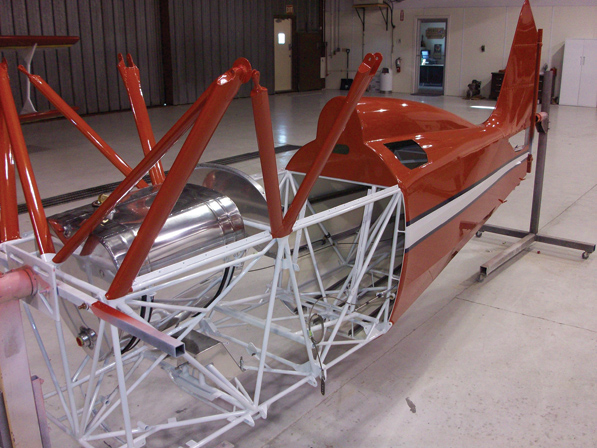
As completion nears, the new fuel tank is in place, and the new baggage compartment opening awaits its door aft of the cockpit.
Structural Integrity
The Starduster’s skeleton was in good condition, and bead blasting cured its few, small patches of surface rust. Magnified investigation of every exemplary gas weld revealed nothing that called for further non-destructive testing. Sheet metal screws held the metal skins to tabs that festooned the fuselage between the cockpit and firewall. Thorough inspections mean taking an airplane apart, Muhle says, and this method of attaching skins invites stripped holes, usually “fixed” with a larger sheet metal screw. An unsightly line of different size screw heads proclaims such fixes, as does the insecurity of empty holes. “If you don’t pull the panel and look behind it because you’re scared of stripping a hole, that ain’t the right thing either.”
Muhle solved this problem by cutting off all of the tabs and replacing them with curved L-shaped formers studded with nut plates. “I know they are a pain to put in, but they are life savers because they are secure, and they last forever,” he said. Similar panels, 8 inches high and about 17 inches long, cover the tail above and below the horizontal tail, fully revealing the control linkages.
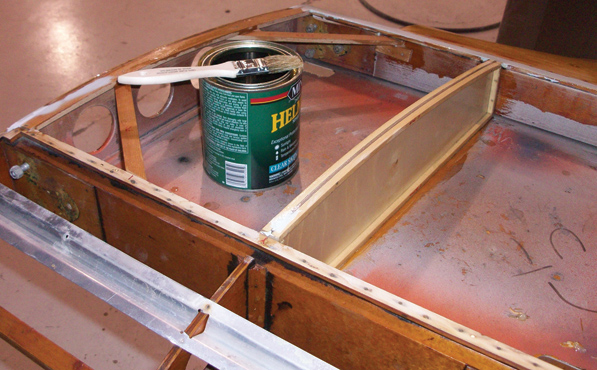
Muhle built new ribs to fill the void once occupied by the wing tank.
The Starduster had Cub-like elevator trim that adjusted the incidence of the horizontal stab, which Arps could see vibrating in flight. Muhle replaced it with a vernier-trimmed servo tab on the elevator, like a Pitts or One Design, which lightens the control forces. After hard-mounting the stab, he complemented the bracing wires with a strut. Despite their age, the original stainless-steel cables that controlled the rudder and ailerons were almost like new, as were their swaged terminals. Back in the day, Muhle explained, control cables were “fully actuated” with pulleys; where appropriate, he replaced them with a bracket and nylon fairlead.
Made to Order
A trim 6-footer, Arps sat high in the cockpit. It took little work to lower the seat and recline its 90 angle. Behind it they built a baggage compartment not unlike that in a Stearman. The 6×16-inch door on the fuselage, aft of the headrest, was a vast improvement over the 4×4-inch cubbyhole behind the headrest. After he weighed the finished airplane and did the weight and balance, the new baggage area, a canvas sling supported by the longerons, will hold 30 pounds.
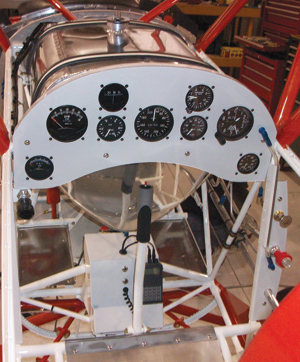
The Starduster got a new panel and instruments; the console holding the Sporty’s SP200 handheld transceiver fits over the landing-gear bungees.
According to its original specifications, the SA-100 carried roughly 20 gallons of fuel in two tanks. Inspecting both of them, Muhle found the fiberglass wing tank laced with spider cracks and the aluminum fuselage tank previously patched. “Given all of the room in the fuselage, I thought we could make a new, bigger fuselage tank and do away with the wing tank,” says Muhle, who made new ribs to fill the center section void. “I did the math on how much I could get out of it, based on the paper pattern, and I figured about 17.5 gallons. After I welded it up and pressure checked it, it held 17.3 gallons.”
The Starduster’s Lycoming O-290-G started out at 125 horsepower, Arps said, but “Central Cylinder Service in Omaha went through it completely, polishing and re-ringing it, so it’s close to 140 now.” In conservatively round numbers, it drinks 6 gph, so “I only wanted 15 gallons.” Arps appreciates the 2.3 extra gallons, but not as much as the new visible fuel gauge tube that runs along the right side of the cockpit. The cockpit also sports a new panel and instruments that replaced the mixed assortment day-VFR gauges, some with the old tan-yellow numbers.
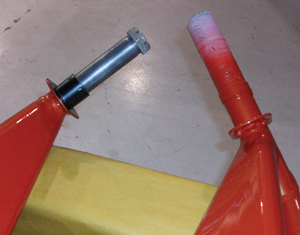
The gear legs, with the new axles welded into the remains of the originals.
An electrical system was one amendment Arps did not consider because he wanted to keep the Starduster true to its era. With practice he got comfortable-but not complacent-with hand-propping the engine. “It’s nostalgic, and I like it,” he said. He communicates with a Sporty’s SP200 handheld transceiver, and in passing, he asked Muhle if he could make some sort of holder for it. A console (with headset jacks) that holds the radio and a GPS now covers the landing gear bungees, which stick up through the cockpit floor about halfway between the stick and rudder pedals. “That turned out very sharp,” Arps said. “It’s another one of Paul’s ‘I can do it’ things.”
Classic Debates
Debating the best course of action is a classic part of every project regardless of how many people are involved. What size wheels the Starduster should wear was the longest running. Originally, it wore 6.00×6 wheels and pants, both showing their age. Muhle felt they looked too big, and 5.00×5 would be better, even though the bigger wheels would be better for Arps’ grass strip. Everyone who visited the hangar offered an opinion, especially the regulars who gathered at Muhle Aviation Works every Friday afternoon for pizza. Finally, Arps relented. When the new wheels arrived, they discovered the axle incompatibility. “I wasn’t paying attention,” Muhle said. “The big wheels use a 1.5-inch axle, and the little ones use 1.25 inchers.”
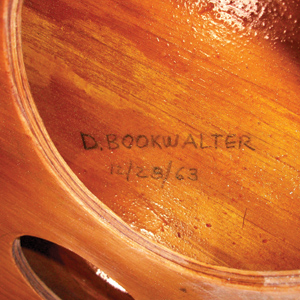
While amending the Starduster, Muhle and Arps found notes from its builder, Bookwalter, who completed this woodwork on 12/29/63, five years before the airplane’s first flight.
This is a big deal with axles welded to the gear legs, Muhle said, and making the change involved a lot of work. Given the debate, Arps surprised Muhle with an elegant solution-for the smaller wheels. The inside diameter of the old axles was the outside diameter of the new ones, so they could cut off what they didn’t need, slide new into old, and affix them with rosette welds. A new set of Pitts-style wheelpants finished the job. In all good humor, Muhle says that Arps still gives him grief because they are so rough on grass.
The tailwheel problem was easier to resolve. Arps ordered a new Maule tailwheel to replace the original, Muhle says, but it was too big; someone must have turned down the original’s hard rubber tire. The new tailwheel didn’t work for either Arps or Muhle, but they quickly found the solution on Muhle’s personal spare-time project, an RV-7. It uses a different spring that slides into the fuselage, but it was an easy change, and it was a perfect size for the Starduster.
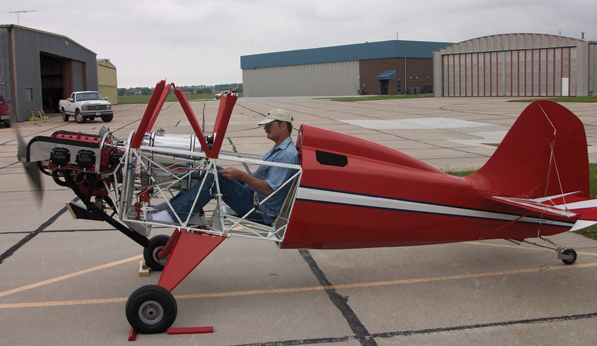
Arps gets some cockpit time running up the engine after re-mating it to the airframe.
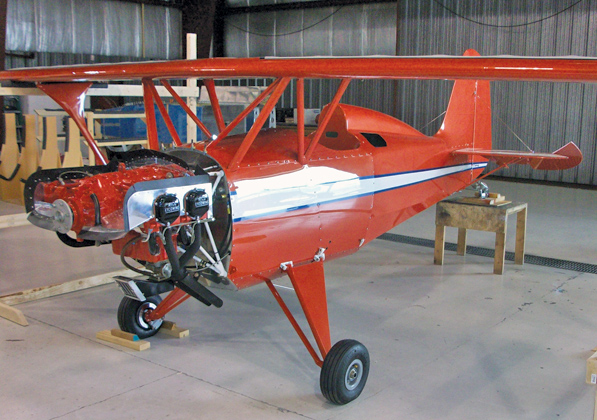
The wings and airframe are reunited, and preparations are made to get the rigging right.
An Auspicious Debut
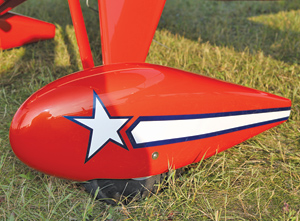
The Starduster wears Pitts-style pants over its new 5.00×5 wheels and tires.
One debate on which Arps held firm was his decision not to fly the finished airplane until Muhle brought it back from EAA AirVenture. “I hate to brag it up,” he said, but the amended Starduster was perfect, and he didn’t want to take any chance of “doing something wrong,” because its return to Oshkosh was the project’s highlight. As he had for his three previous pilgrimages, Arps and his wife, Patricia, drove. (Their three boys and a girl, all in their 20s, didn’t make the trip.)
“I felt bad,” Muhle said, “but I couldn’t get him to fly it until after Oshkosh. Alan is firm in his words, and he means what he says.” Earning the Founder’s Award for Best Classic Homebuilt surprised them both. “We were only there for a day,” Arps said. “There were some very nice planes there in the same category as the Starduster, so I was very pleased with the award.”
Since their return from Oshkosh, Arps has logged about 30 hours in his amended Starduster. He’s not yet flown any aerobatics, “but that’s coming up shortly,” he said quietly. Shortly, as in the 2011 flying season.
